Nile Cruise - Once In A Lifetime
January 2008 by Kathi Jacobs
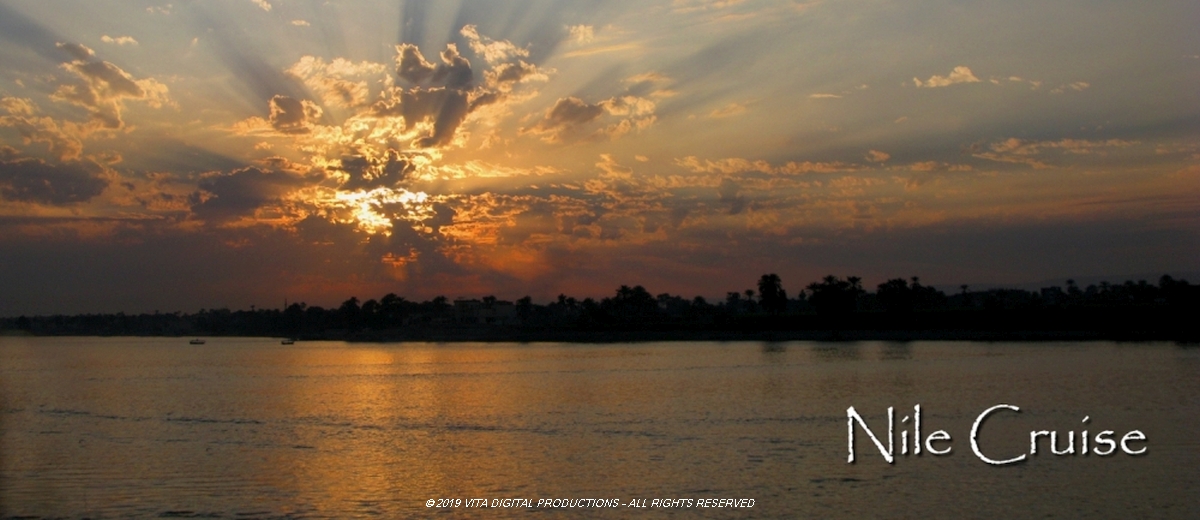
For the next 7 nights, we'll cruise the Nile River, the longest river in the world. Silt deposits from the Nile made the surrounding land fertile because the river overflowed its banks annually. The Ancient Egyptians cultivated and traded wheat, flax, papyrus and other crops around the Nile. Wheat was a crucial crop in the famine-plagued Middle East. This trading system secured Egypt's diplomatic relationships with other countries, and contributed to economic stability. Far-reaching trade has been carried on along the Nile since ancient times.
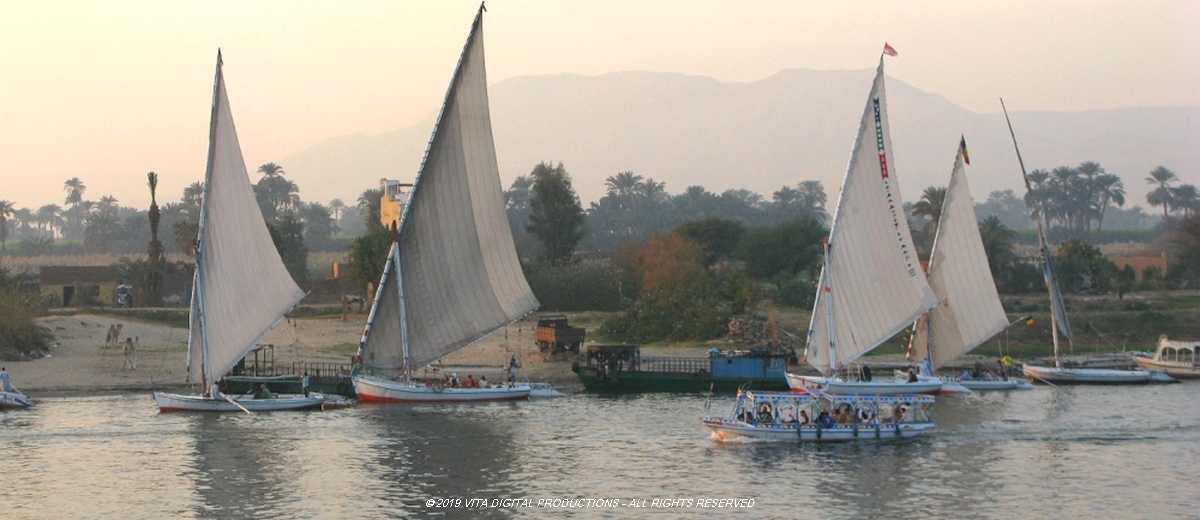
Most of the population and cities of Egypt lie along those parts of the Nile valley north of Aswan and nearly all the cultural and historical sites of Egypt are found along riverbanks.
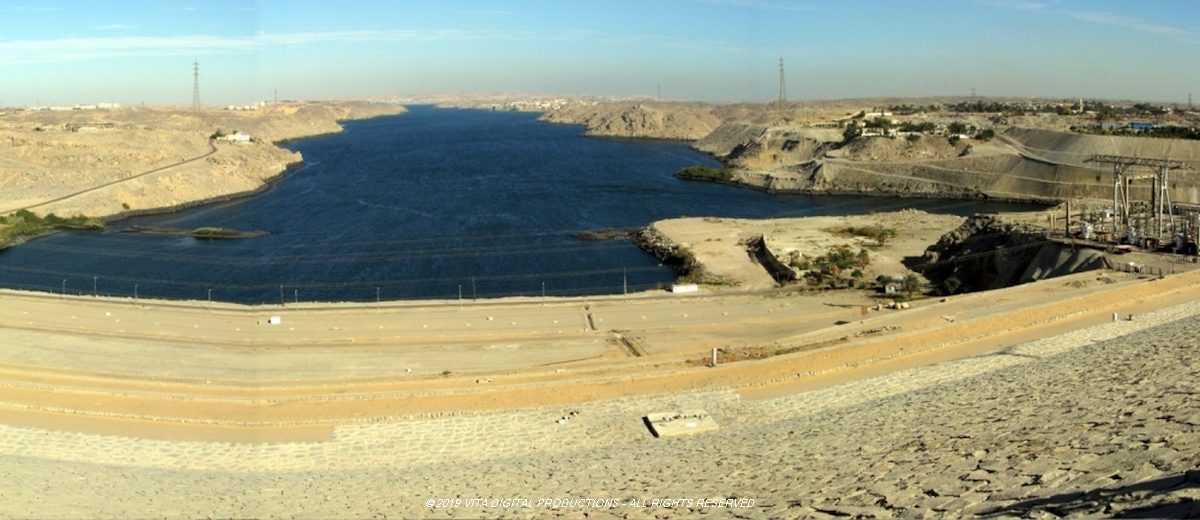
Friday, 4 January - We had an early departure this morning to fly from Cairo to Aswan. When we arrived in Aswan, there was a brief tour of the High Dam at Lake Nasser. The English, when they were the occupying force in Egypt in the early 1900s, built the British Dam. It served its purpose at the time, but soon Egypt's population had outgrown the water supply. The Aswan High Dam was built in the 1960s and has the ability to control flooding better, provide increased water storage for irrigation, and generate hydroelectricity pivotal to Egypt's planned industrialization. The High Dam has had a significant effect on both the economy and culture of Egypt.
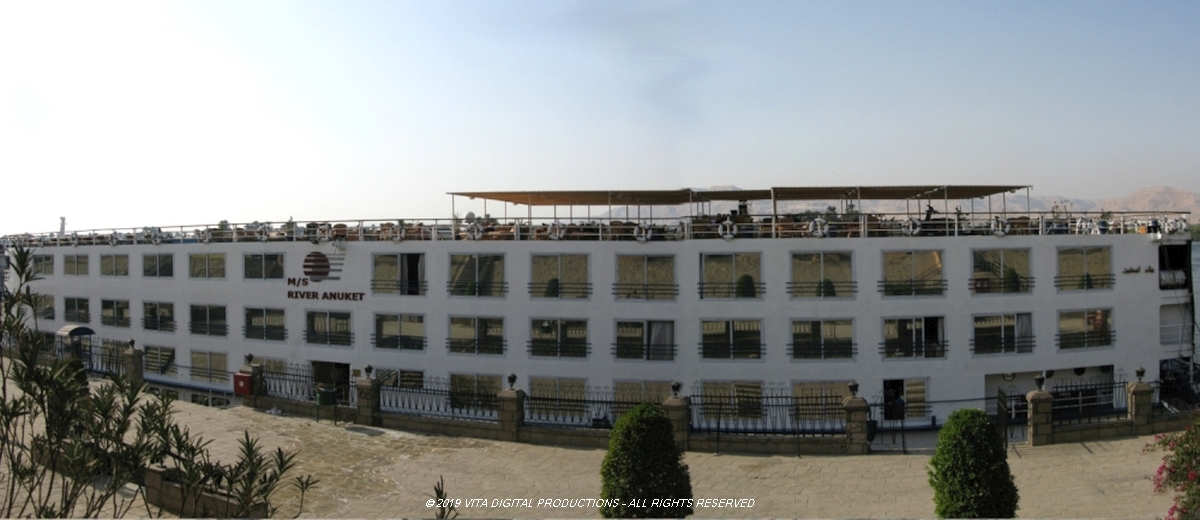
Our home for the cruise will be the MS Anuket, a really beautiful boat with a friendly and attentive staff and crew. There were always smiling faces to greet us and send us off, and great attention was paid to details throughout the boat. With five decks and a passenger maximum of 134 passengers, each of us should be properly spoiled all along the way.
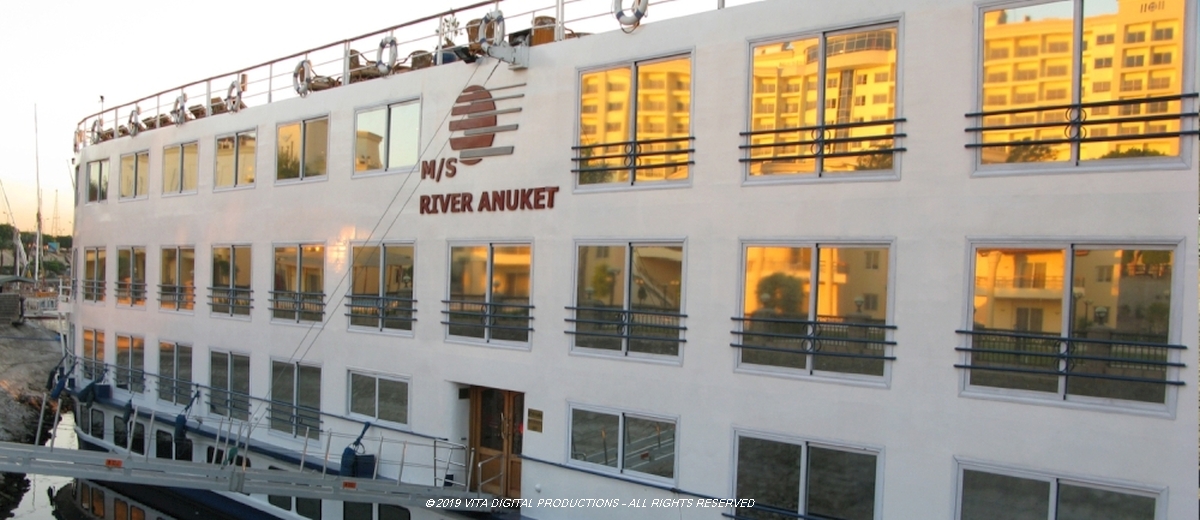
We boarded our boat in time for lunch and that – as well as all other meals – was excellent! There were two executive chefs on board this 5-star vessel and a host of young waiters with energy and a good sense of humor.
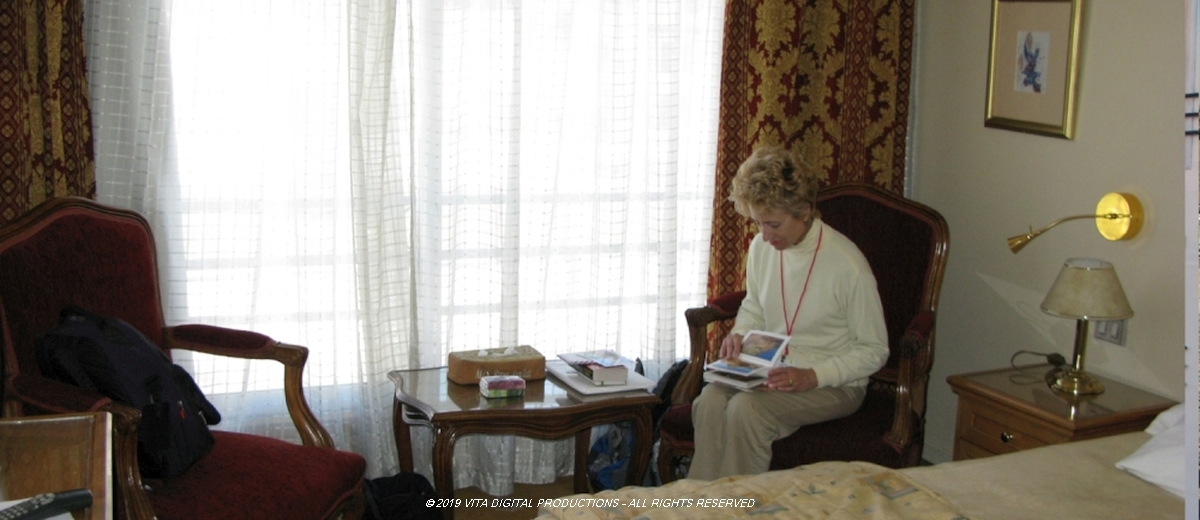
The pace while we were actually on the river was quite relaxed. As much as we had enjoyed our time in Cairo, there was always so very much to see and do that the time on the cruise offered a welcome respite. Our cabin, #302, was located on the Lounge deck. Large sliding glass doors with unobstructed views were a nice feature to these rather spacious cabins. A good overall layout and a steward most willing to please made the Anuket a pleasurable craft.
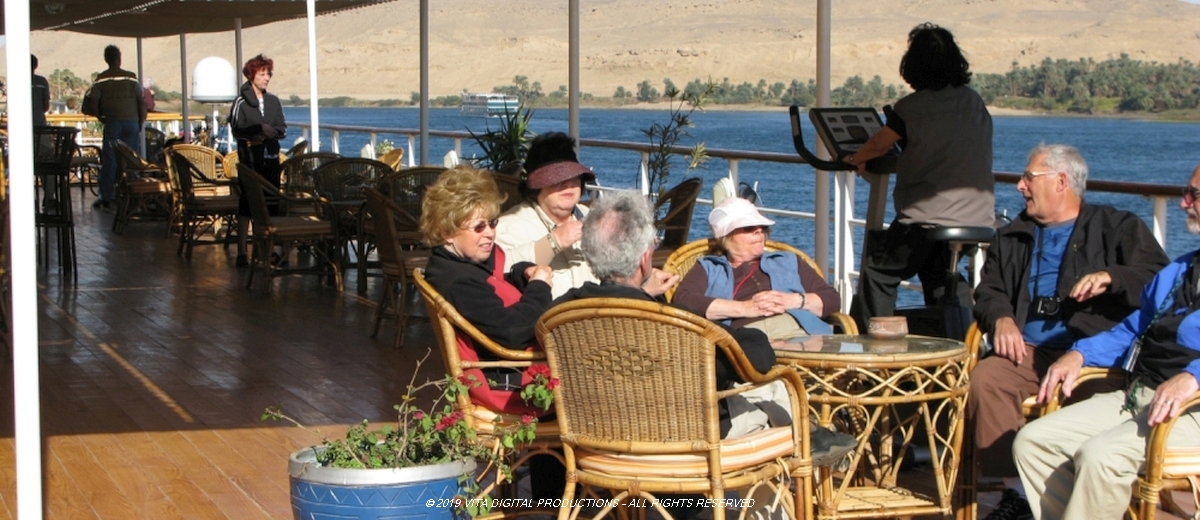
Our group (all 4 busloads) took over the whole boat for the week, so we had a chance to converse and enjoy meals together.

Saturday - 5 January - After a short flight south to Abu Simbel, we visited the temples carved right into the mountain by Ramesses II for himself and his most favored wife, the beautiful Nefertari. Located at the second cataract of the Nile River, the two temples which comprise the site (The Great Temple and The Small Temple) were created during the reign of Ramesses II (c. 1279 - c. 1213 BCE.) With the passage of time, the temples fell into disuse and eventually became covered by sand. By the 6th century BC, the sand already covered the statues of the main temple up to their knees.
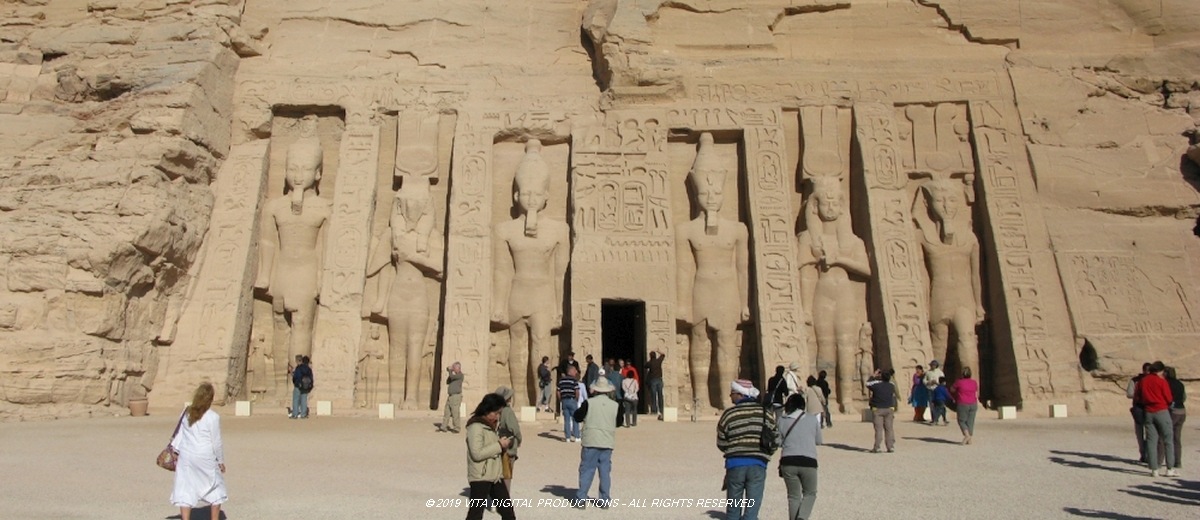
The temple was forgotten until 1813, when Jean-Louis Burckhardt found the top frieze of the main temple. Burckhardt talked about his discovery with Italian explorer Giovanni Belzoni who, in 1817, this time succeeded in his attempt to enter the complex. In 1959 the southernmost relics of this ancient human civilization were under threat from the rising waters of the Nile that were about to result from the construction of the Aswan High Dam. Of course, we did extensive filming and photography here.
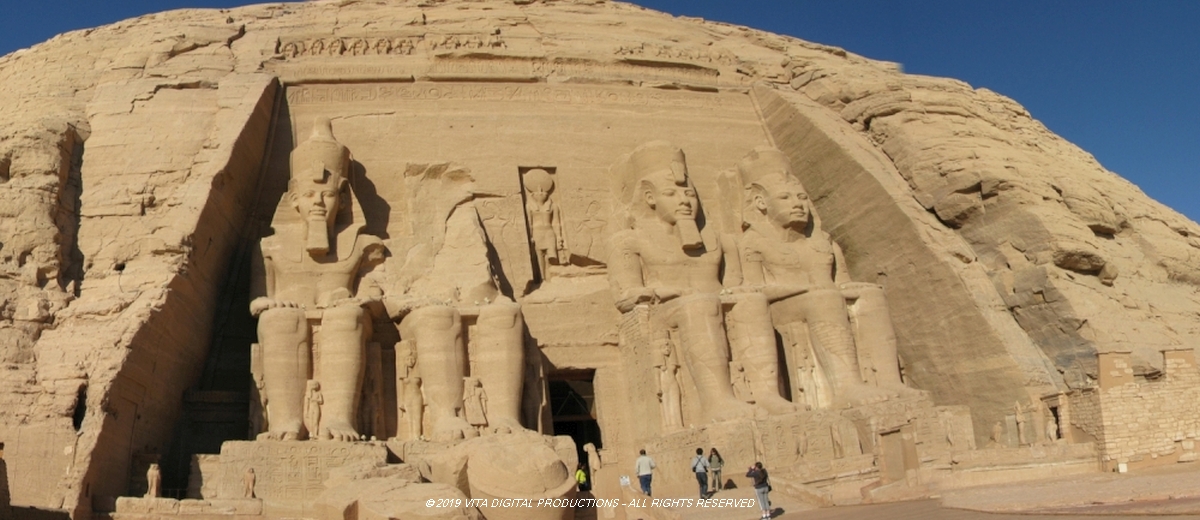
The salvage of the Abu Simbel temples began in 1964 by a multinational team of archeologists, engineers and skilled heavy equipment operators working together under the UNESCO banner; it cost some USD $40 million at the time (equal to $300 million in 2017 dollars). Between 1964 and 1968, the entire site was carefully cut into large blocks (up to 30 tons, averaging 20 tons), dismantled, lifted and reassembled in a new location 65 meters higher and 200 meters back from the river, in one of the greatest challenges of archaeological engineering in history.
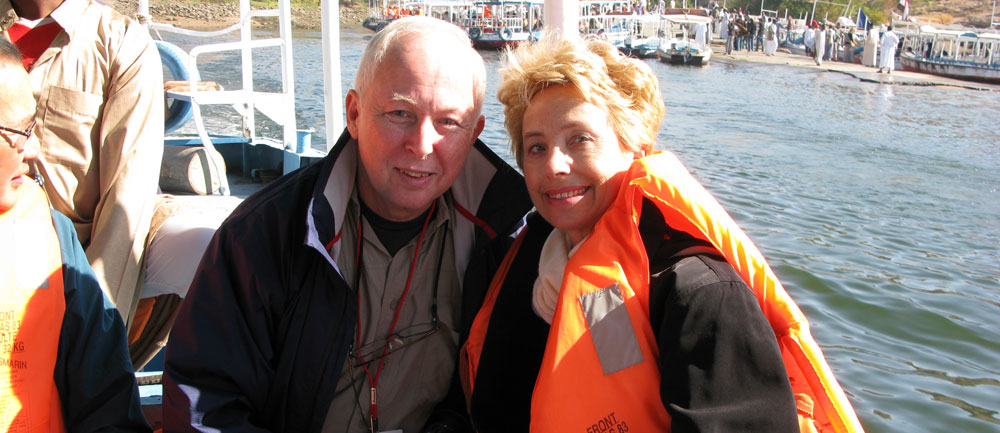
Sunday - 6 January - The first port on the cruise was the island of Philae. We were taken by bus to a small boat dock where we would begin our actual trip to the island. During the Victorian era in England, Egypt was part of the Grand Tour and certainly this spot would have garnered great interest by those Europeans. The island is in the reservoir of the Aswan Low Dam, downstream of the Aswan Dam and Lake Nasser.
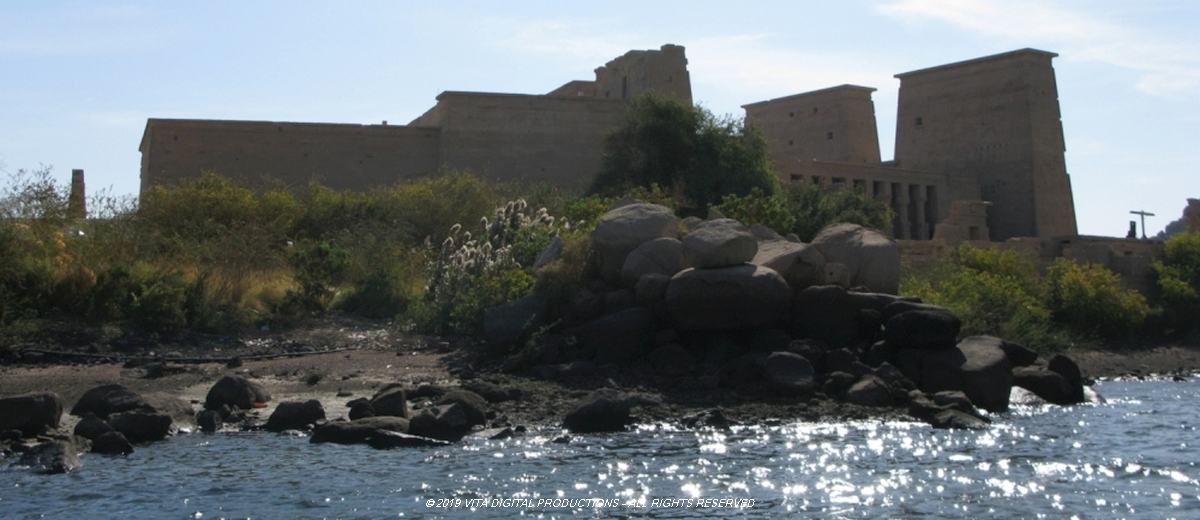
A quote attributed to Amelia Edwards in the 1870s describes the site just as I remember it: “The approach by water is quite the most beautiful. Seen from the level of a small boat, the island, with its palms, its colonnades, its pylons, seems to rise out of the river like a mirage. Piled rocks frame it on either side, and the purple mountains close up the distance. As the boat glides nearer between glistening boulders, those sculptured towers rise higher and even higher against the sky. They show no sign of ruin or age. All looks solid, stately, perfect. One forgets for the moment that anything is changed. If a sound of antique chanting were to be borne along the quiet air–if a procession of white-robed priests bearing aloft the veiled ark of the God, were to come sweeping round between the palms and pylons–we should not think it strange.”
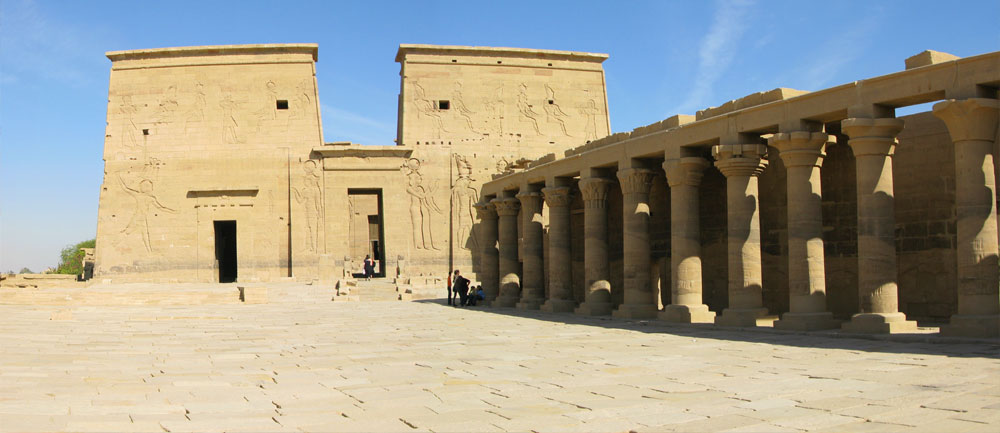
The construction of the Aswan Dam would have resulted in the temple being totally submerged under Lake Nasser. Therefore, the temple complex was dismantled and moved to nearby Agilkia Island as part of the UNESCO Nubia Campaign project, protecting this and other complexes before the 1970 completion of the Aswan High Dam.
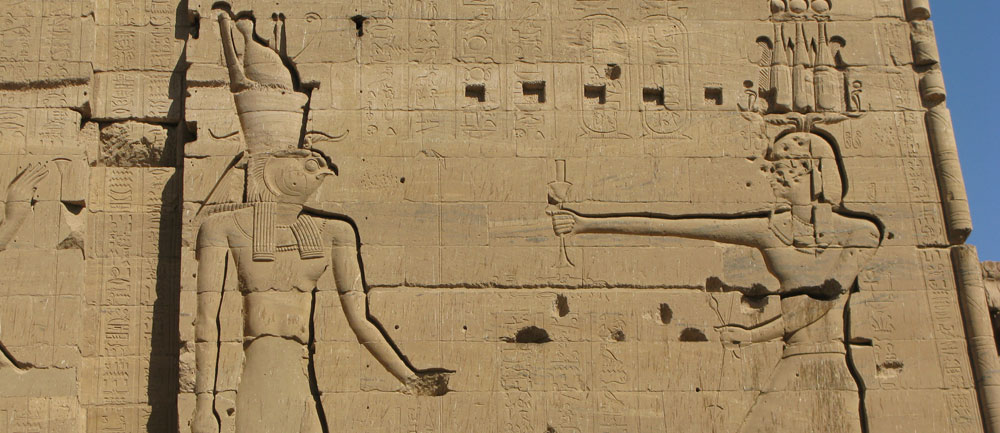
Since Philae was said to be one of the burying-places of Osiris, it was held in high reverence both by the Egyptians to the north and the Nubians to the south.
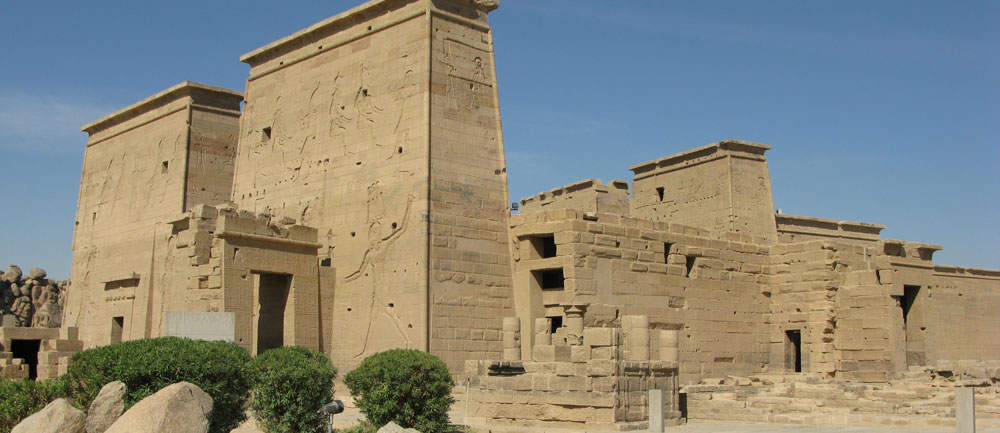
Philae also was remarkable for the singular effects of light and shade resulting from its position near the Tropic of Cancer. As the sun approached its northern limit the shadows from the projecting cornices and moldings of the temples sink lower and lower down the plain surfaces of the walls, until, the sun having reached its highest altitude, the vertical walls are overspread with dark shadows, forming a striking contrast with the fierce light which illuminates all surrounding objects.
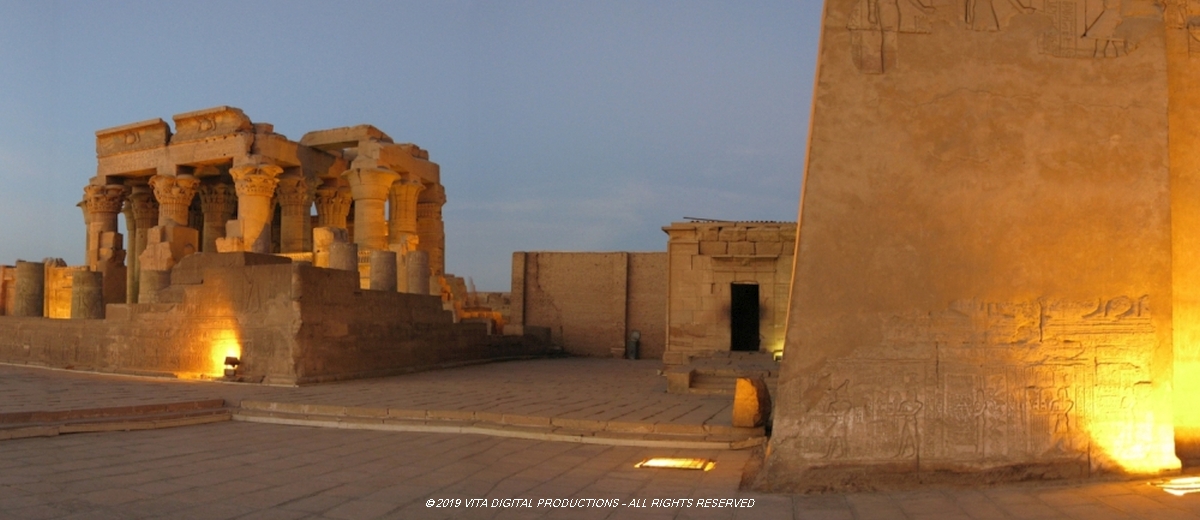
Later in the afternoon we visited Kom Ombo. The Temple of Kom Ombo is an unusual double temple constructed during the reign of the Ptolemies, 180–47 BC. The building is unique because its 'double' design meant that there were courts, halls, sanctuaries and rooms duplicated for two sets of gods: Sobek, the crocodile god; and Horus, the falcon god. Kathi took digital photographs while I did extensive filming.
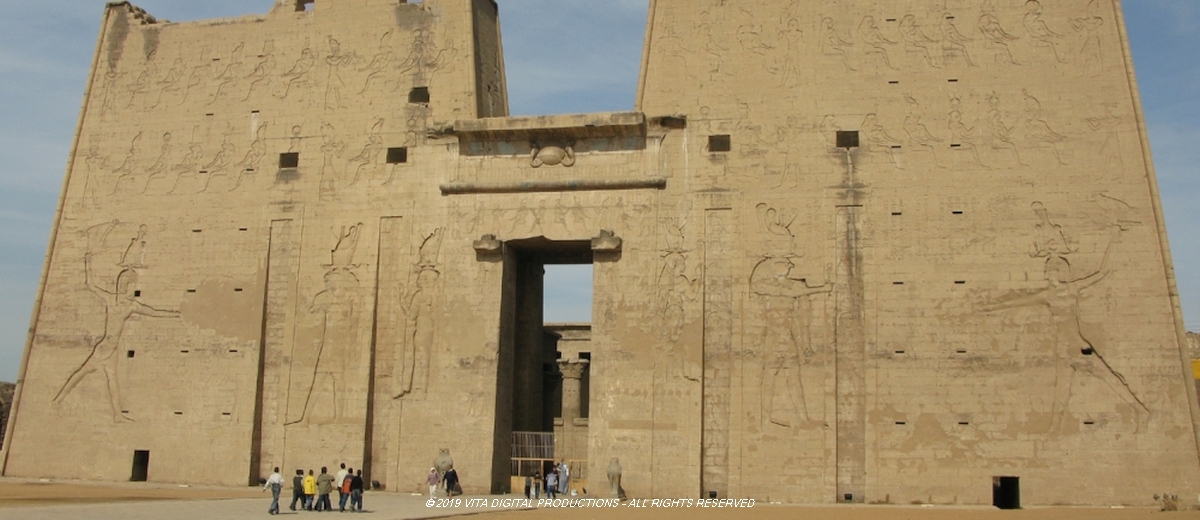
Monday - January 7 - Our boat sailed to Edfu where we toured and filmed the Temple of Edfu which is located on the west bank of the Nile in Upper Egypt. The temple is the largest one dedicated to Horus and Hathor of Dendera. This is the main entrance of Edfu Temple showing the first pylon.
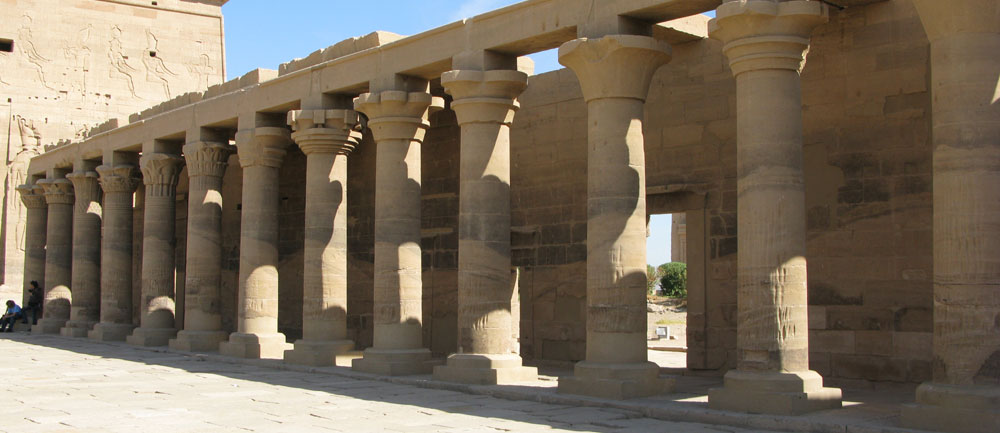
Edfu was one of several temples built during the Ptolemaic Kingdom, including the Dendera Temple complex, Esna, the Temple of Kom Ombo, and Philae. Its size reflects the relative prosperity of the time. The building was started on 23 August 237 BC during the reign of Ptolemy III Euergetes and completed in 57 BC under Ptolemy XII Auletes.
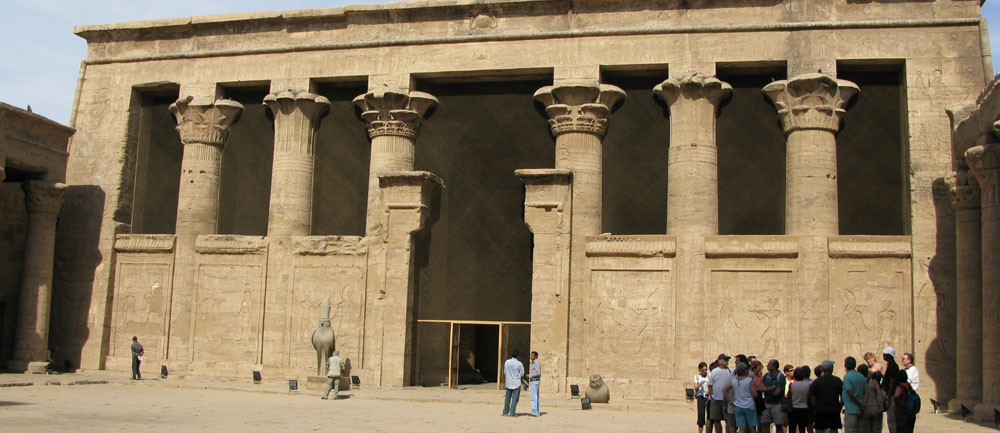
The Temple of Edfu is nearly intact and a very good example of an ancient Egyptian temple. This is the second pylon, the entrance to the inner temple.
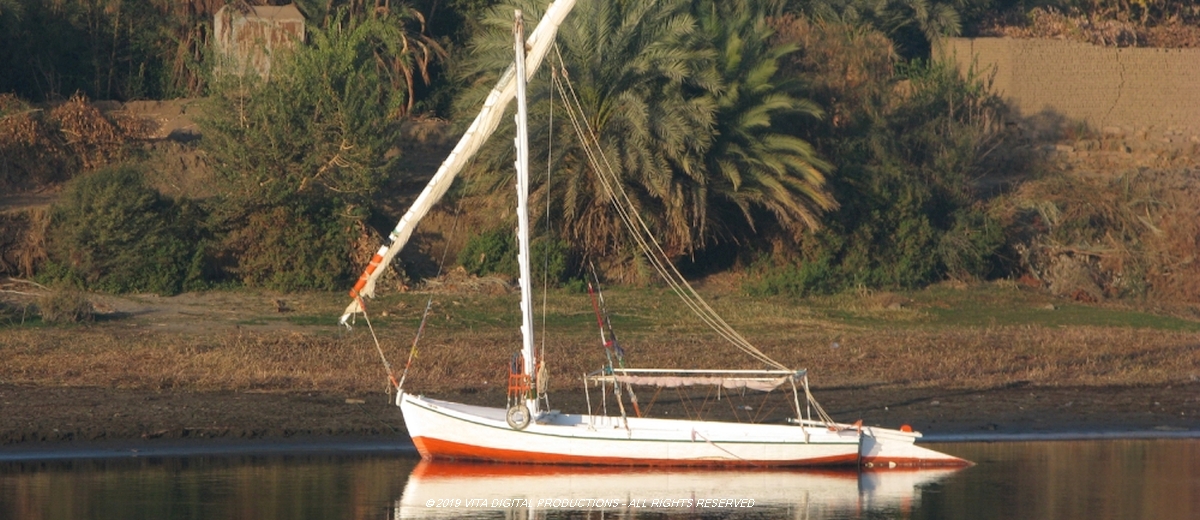
TRAVEL TIP: be in the know when you're traveling in Egypt and be aware that the Nile River flows south to north. In ancient times, the north was known as Lower Egypt and the south was designated as Upper Egypt.
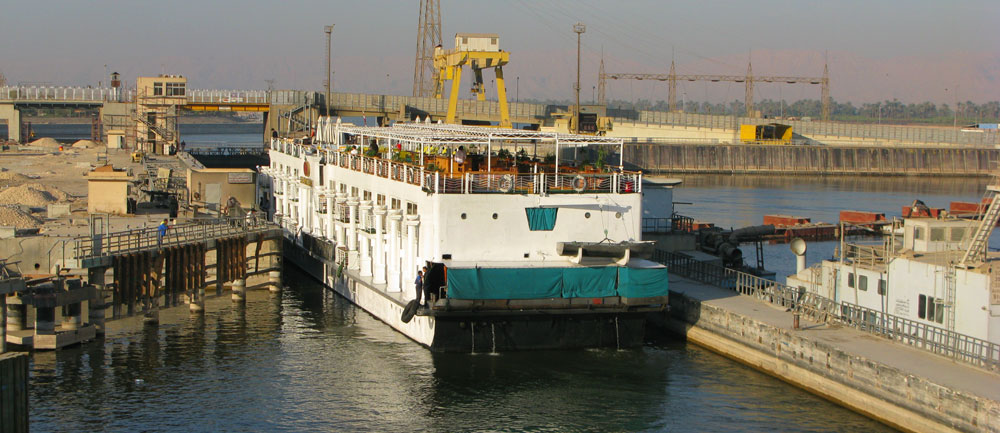
In the afternoon, our ship sailed for Luxor. In order to get there, we had to go through the Esna Lock. While we were waiting for the lock to open for us, several small boats came to the side of the boat and tossed up to the top deck various articles in sealed plastic bags for sale, mostly linens. Next the price was negotiated, consisting of shouting back and forth between the top deck of the ship and the small boats below. If the price was agreed upon, the linen would be removed and the money placed inside and tossed back to the boats below, otherwise the plastic bag with the linen would be tossed back to the boats. A most interesting process.
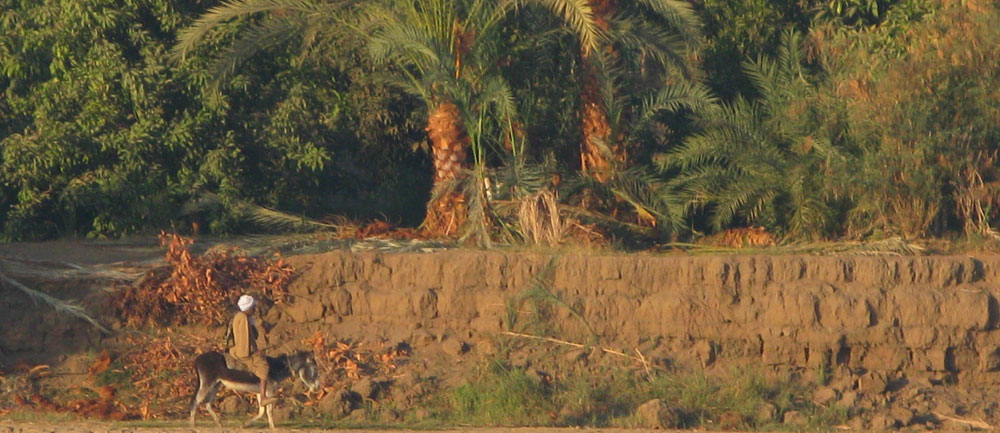
Enroute to Luxor, our boat passed through some of the most incredibly beautiful scenery you could imagine. On the banks of the Nile, we could see the daily life of the Egyptians, still much like that of their ancient ancestors.
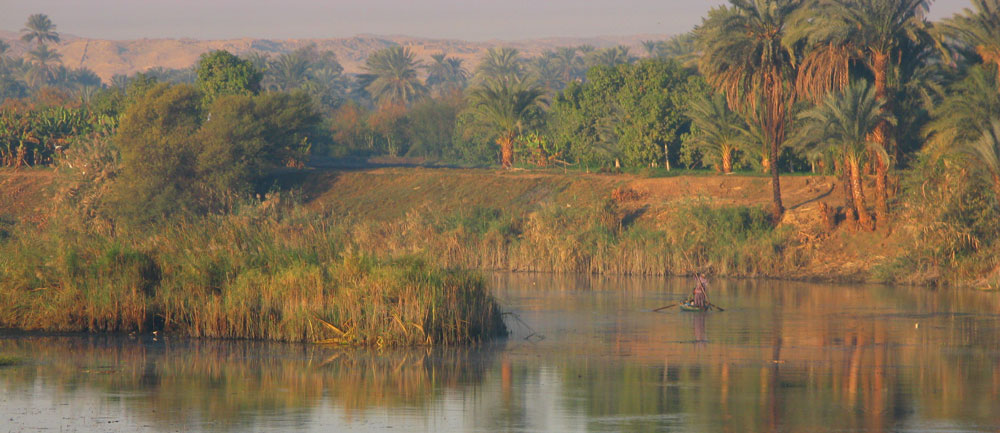
We even saw an Egyptian spear fishing. Using a sharpened stick, spear fishing is an ancient method of fishing that has been used throughout the world for millennia.
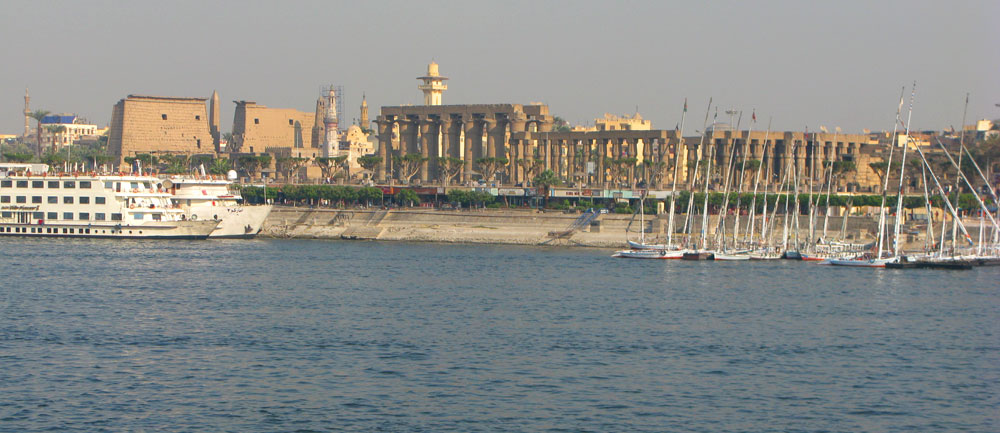
Tuesday - 8 January - Awake after spending our first night docked at the city of Luxor, the site of the Ancient Egyptian city of Thebes, Luxor has frequently been characterized as the "world's greatest open-air museum", as the ruins of the temple complexes at Karnak and Luxor stand within the modern city. Immediately opposite, across the River Nile, lie the monuments, temples and tombs of the West Bank Necropolis, which includes the Valley of the Kings and Valley of the Queens.
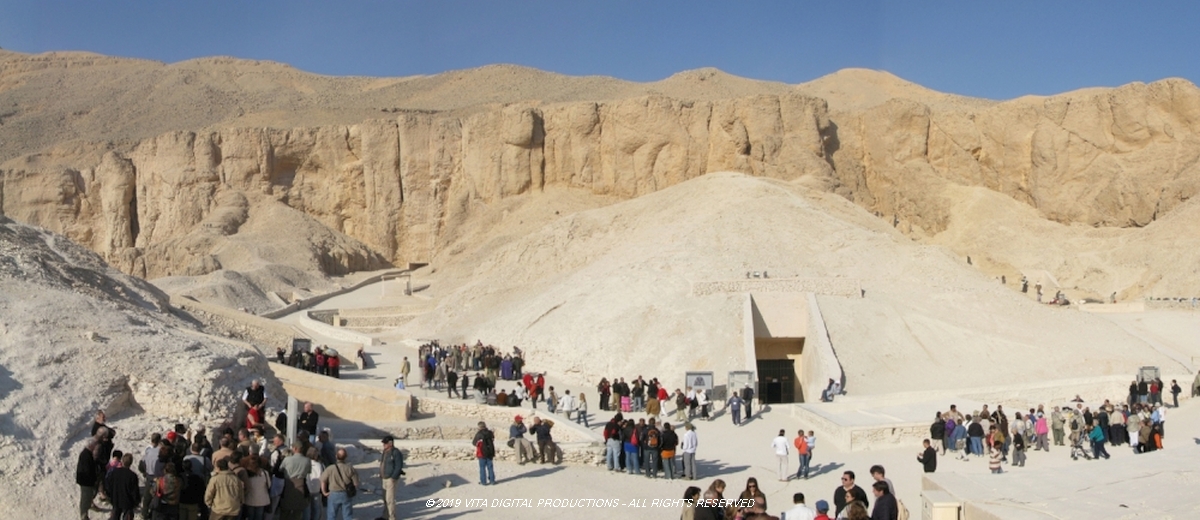
After breakfast, we finally reached the place which many of us anticipated: the Valley of the Kings. Here in this valley, for a period of nearly 500 years from the 16th to 11th century BC, rock cut tombs were excavated for the pharaohs and powerful nobles of the New Kingdom (the Eighteenth to the Twentieth Dynasties of Ancient Egypt).
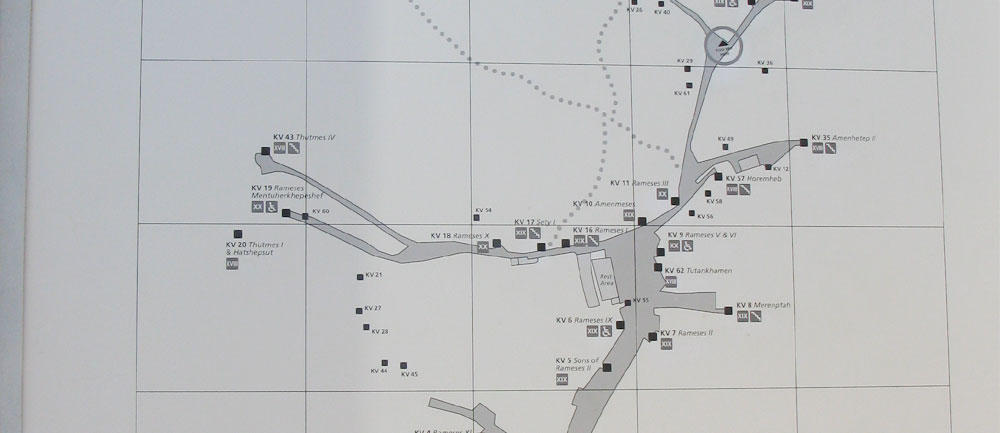
This area has been a focus of archaeological and egyptological exploration since the end of the eighteenth century, and its tombs and burials continue to stimulate research and interest. In modern times the valley has become famous for the discovery of the tomb of Tutankhamun.
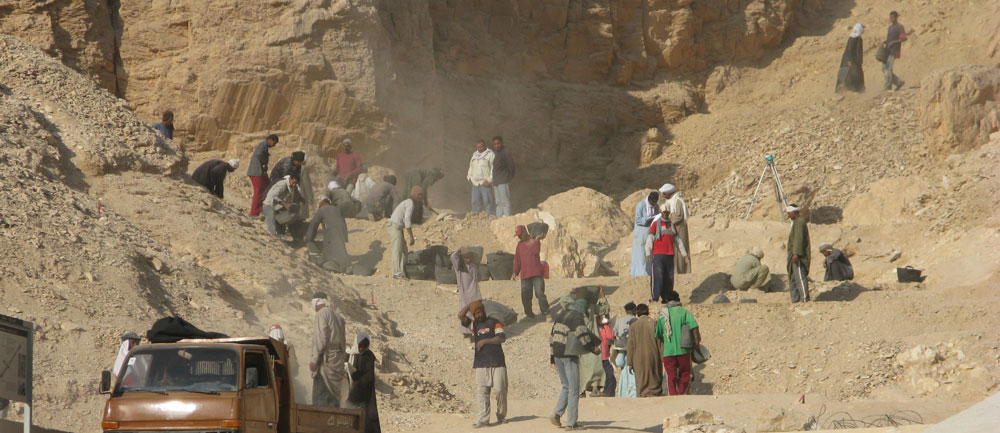
Archaeological work continues in the Valley of the Kings with various expeditions still digging in the valley, adding greatly to the knowledge of the area.
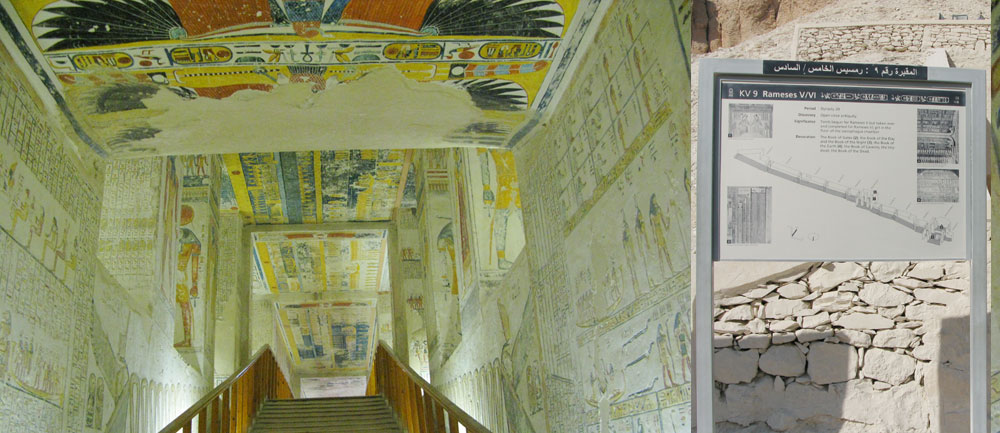
One of the more important tombs in the Valley of the Kings is KV9 - This tomb was originally constructed by Pharaoh Ramesses V. He was interred here, but his uncle, Ramesses VI, later reused the tomb as his own. The ceiling depicts the barks of Ra and the Books of the Day and Night.
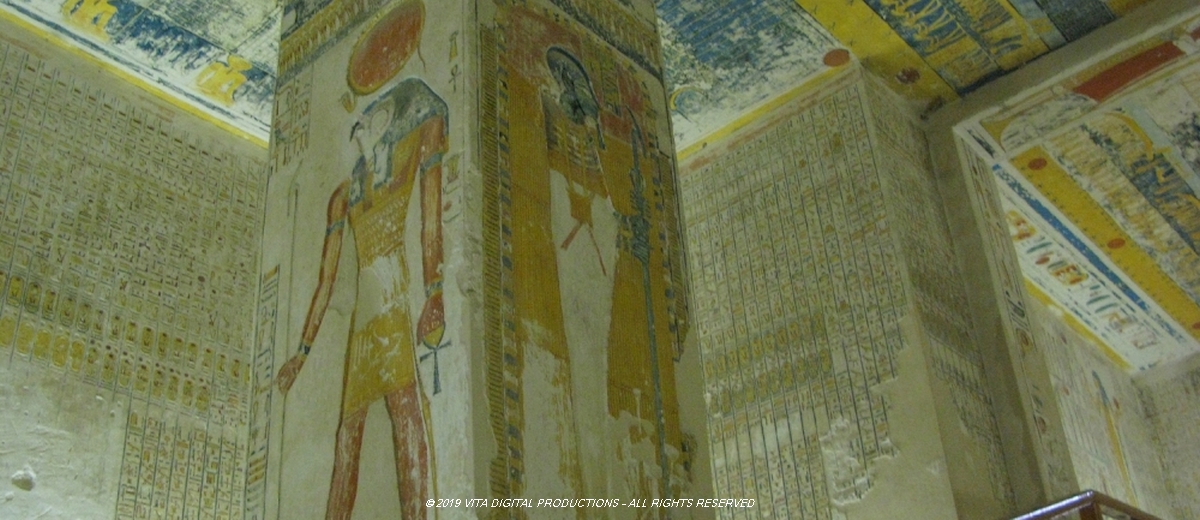
It is not known whether Rameses VI removed the body of Rameses V, or if the two kings shared the tomb. KV 9 has been open (robbed) since antiquity.
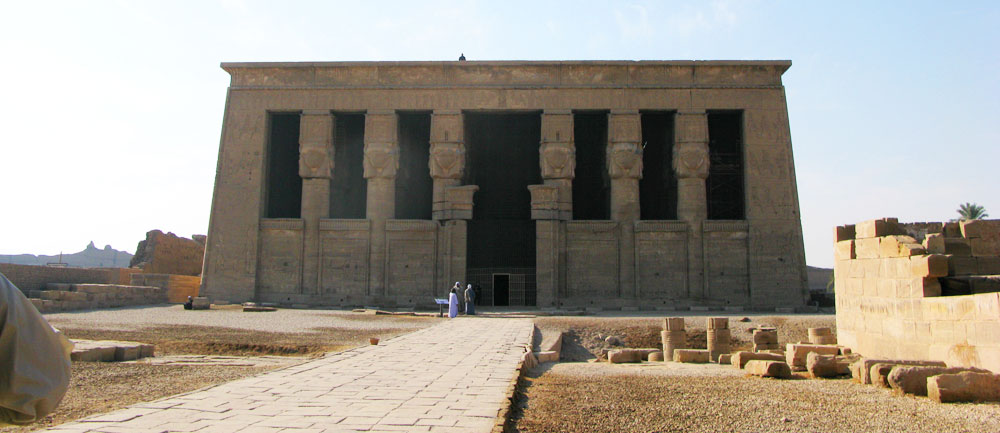
Wednesday - 9 January - We departed for the Dendera Temple Complex. It is one of the best preserved temples in Egypt. The whole complex covers some 40,000 square meters and is surrounded by a hefty mud brick enclosed wall
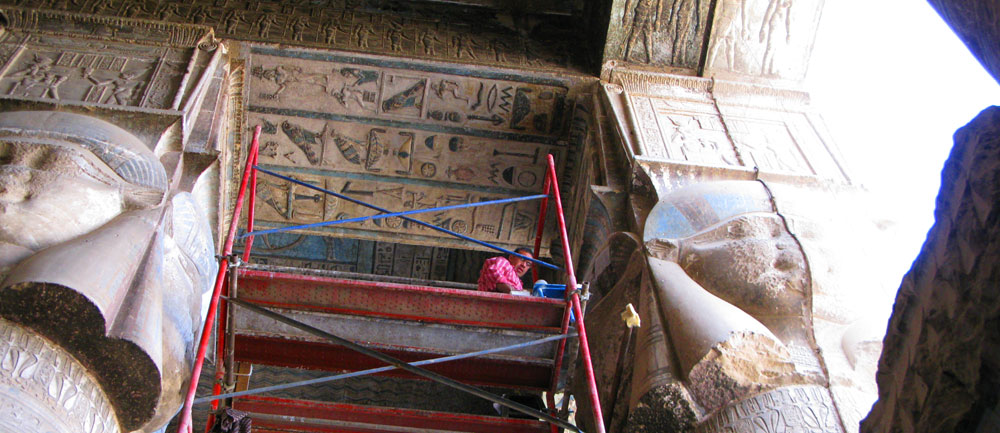
The ceiling of the Hathor Temple was in the process of being cleaned to remove hundreds of years of black soot without harming the ancient paint underneath. Spectacular ceiling painting has been exposed in the main hall, and some of the most vibrant and colourful paintings dating from antiquity are now visible.
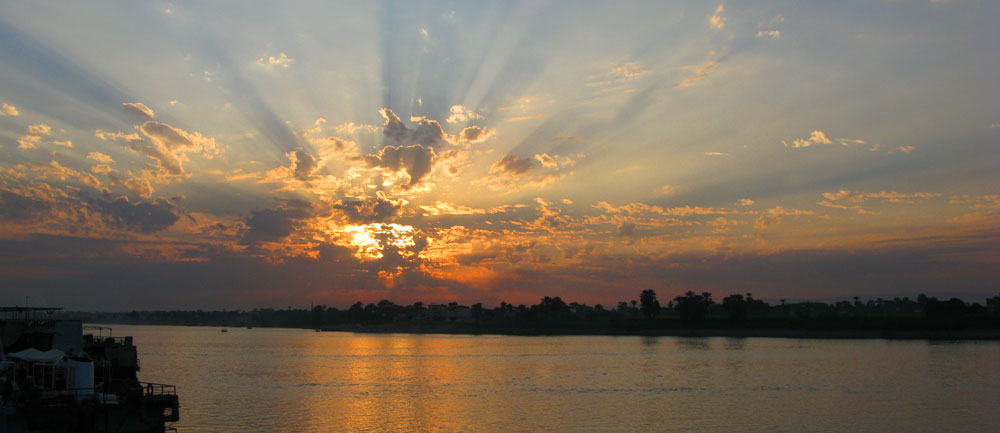
That evening back on our boat, we were treated to a glorious sunset over the Nile.
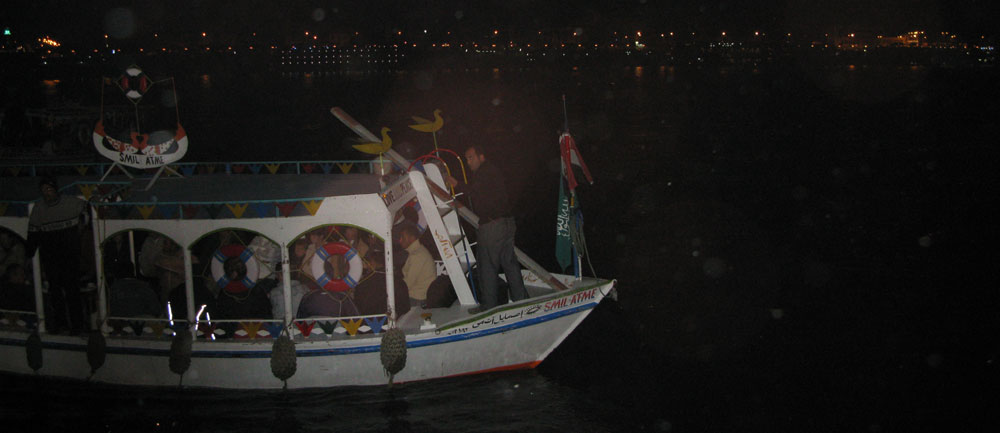
Thursday - 10 January - Up early at 4 AM for a boat ride across the Nile and a sunrise hot air balloon ride over the Valley of the Kings.
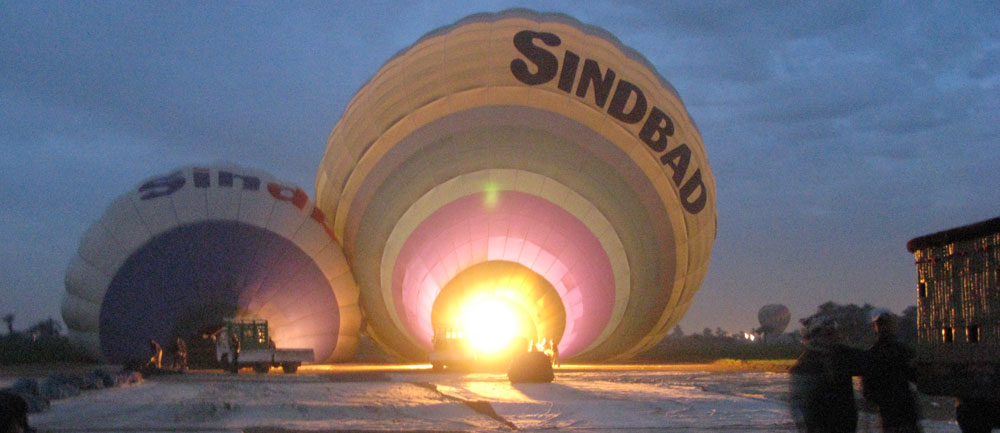
We arrived at the launch site to see our balloons being inflated - very impressive.
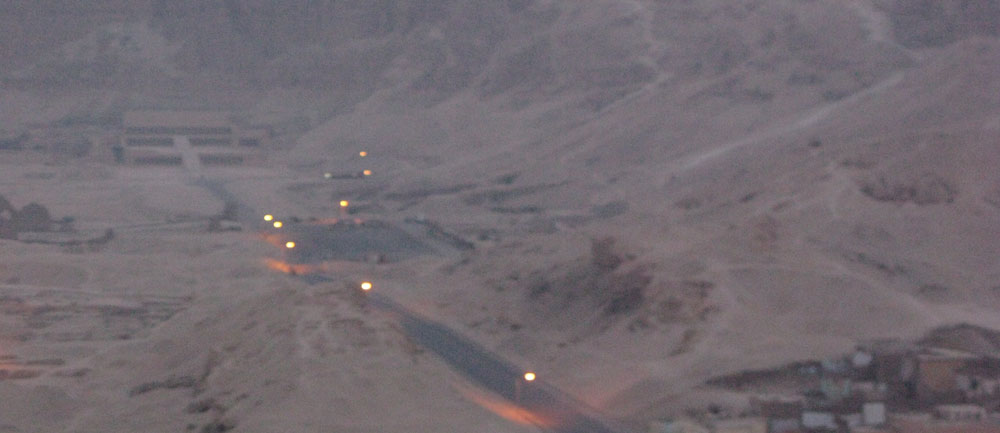
Even though it was right before sunrise, the first thing we saw once the balloon was aloft was Deir el Bahri, a complex of mortuary temples and tombs located on the west bank of the Nile, opposite the city of Luxor. This is a part of the Theban Necropolis.
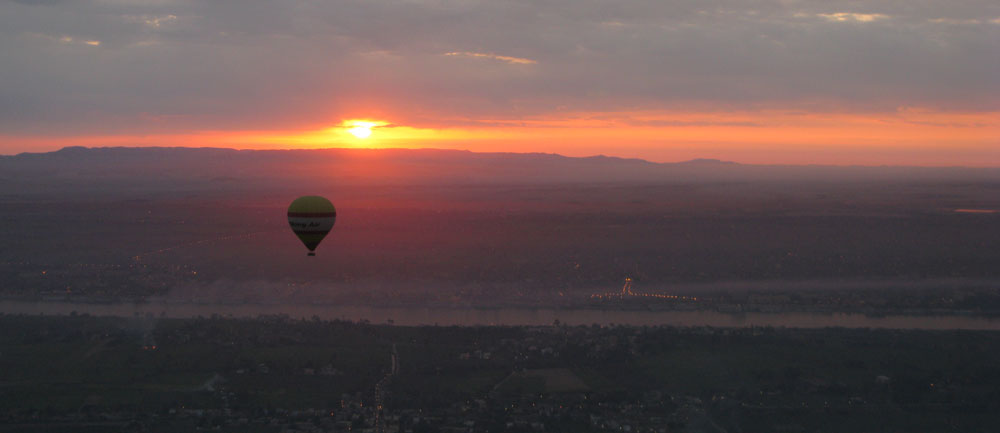
From the hot air balloon, the sunrise over Luxor and the Nile was spectacular.
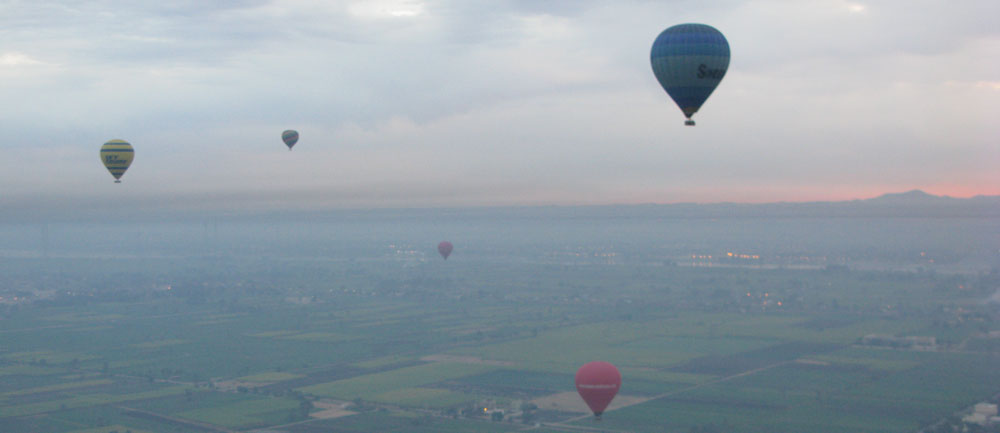
Hot air balloon rides over this area are very popular and well worth the price.
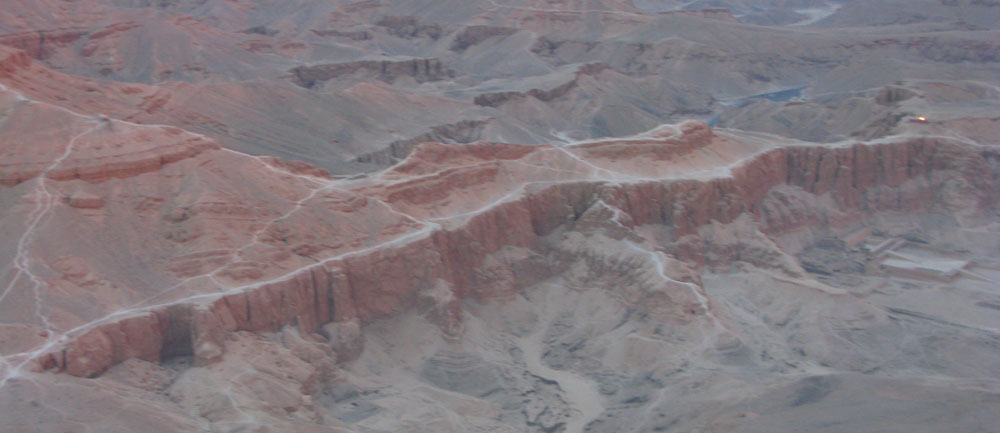
The scenery is magnificent...
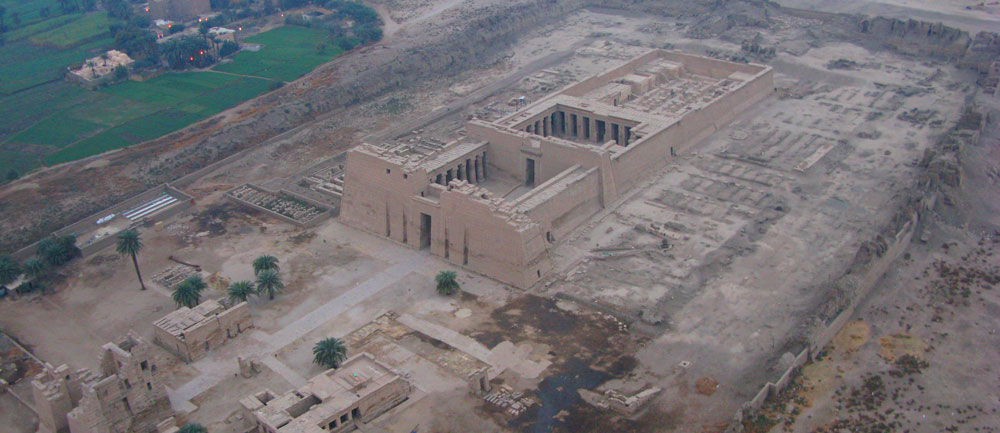
... and you'll even see Egyptian Temples from a completely different perspective.
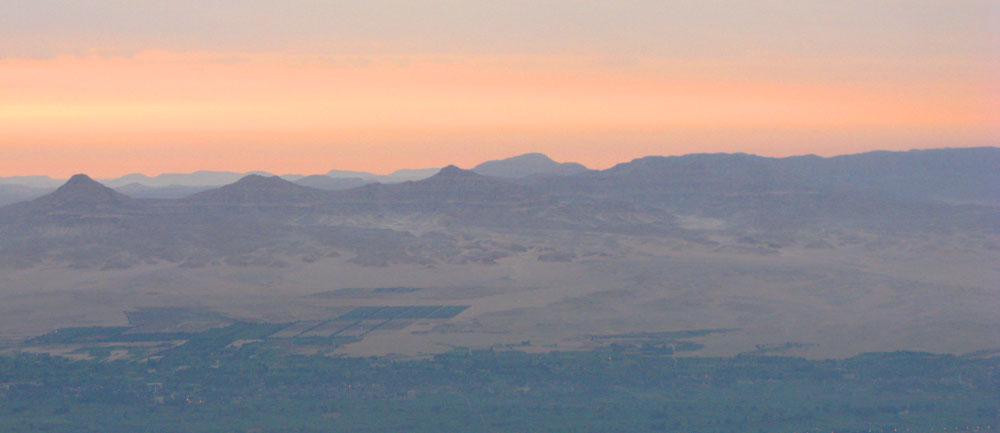
Looking eastward across the Nile, you see the mountains in the distance.
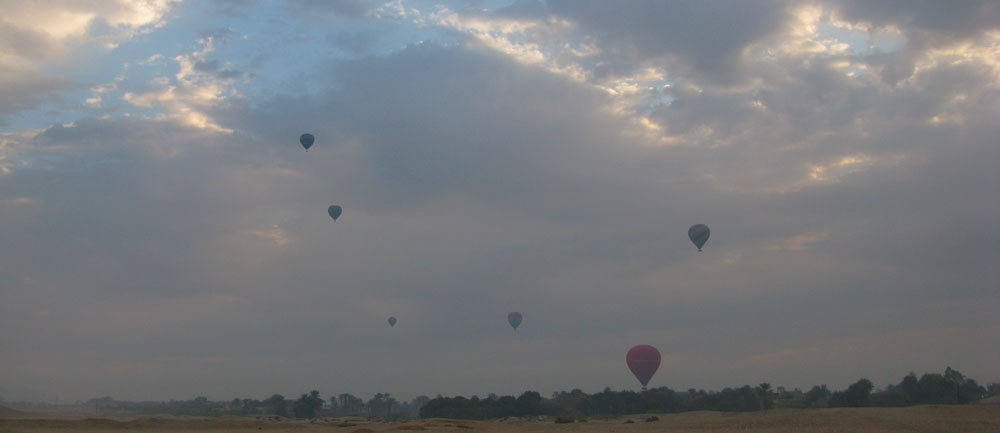
After well over an hour in the air, our unforgettable Egyptian hot air balloon ride comes to an end and we return to earth.
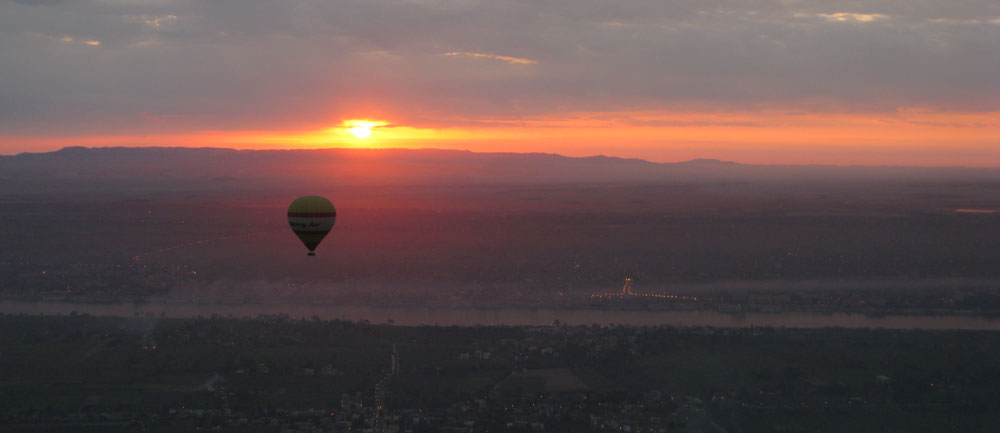
After returning to the ship for breakfast, at 9 AM we departed for the Temple of Karnak which is comprised of a vast mix of decayed temples, chapels, pylons, and other buildings near Luxor.
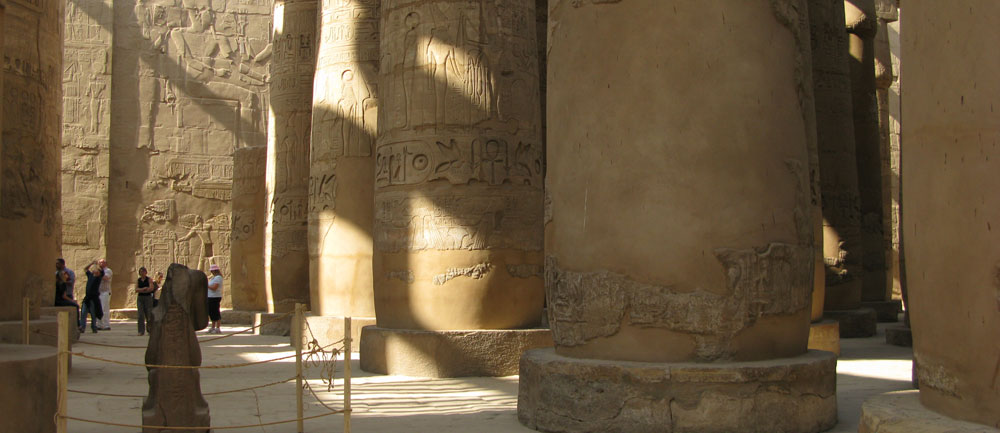
The key difference between Karnak and most of the other temples and sites in Egypt is the length of time over which it was developed and used. Construction of temples started in the Middle Kingdom and continued into Ptolemaic times.
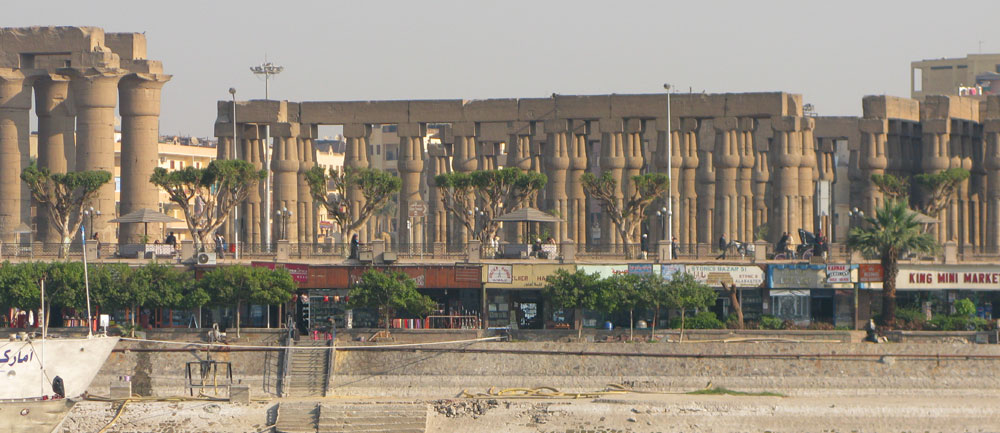
Approximately thirty pharaohs contributed to the buildings, enabling it to reach a size, complexity, and diversity not seen elsewhere. Few of the individual features of Karnak are unique, but the size and number of features are overwhelming.
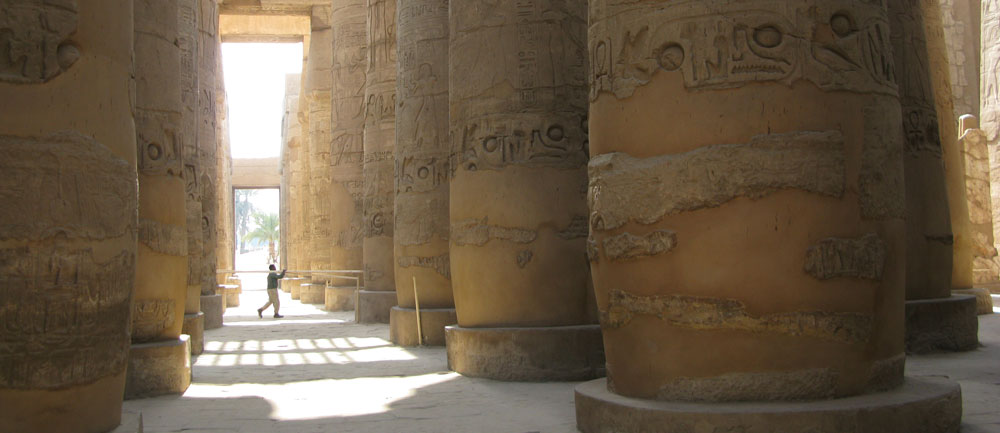
One famous aspect of Karnak is the Hypostyle Hall in the Precinct of Amun-Re, a hall area of 50,000 sq ft (5,000 m2) with 134 massive columns arranged in 16 rows. 122 of these columns are 10 meters tall, and the other 12 are 21 meters tall with a diameter of over three meters.
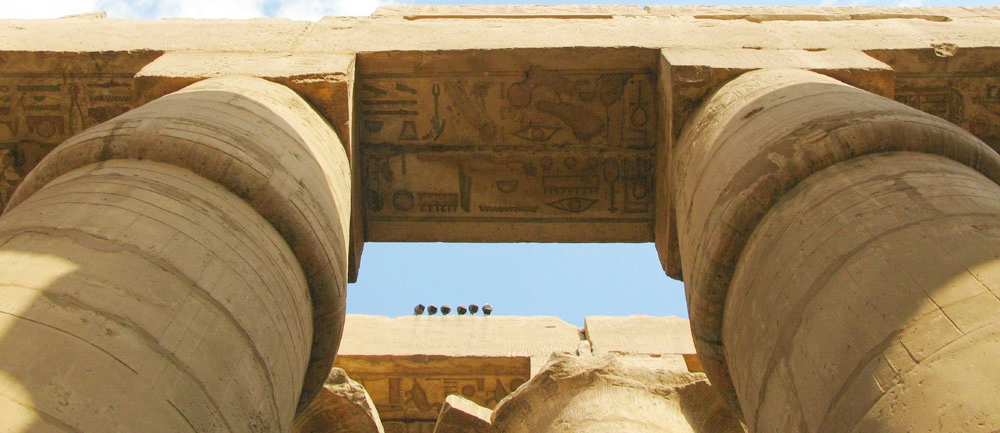
Amazingly, one can still see the original colors under these stone beams, preserved for millennia.
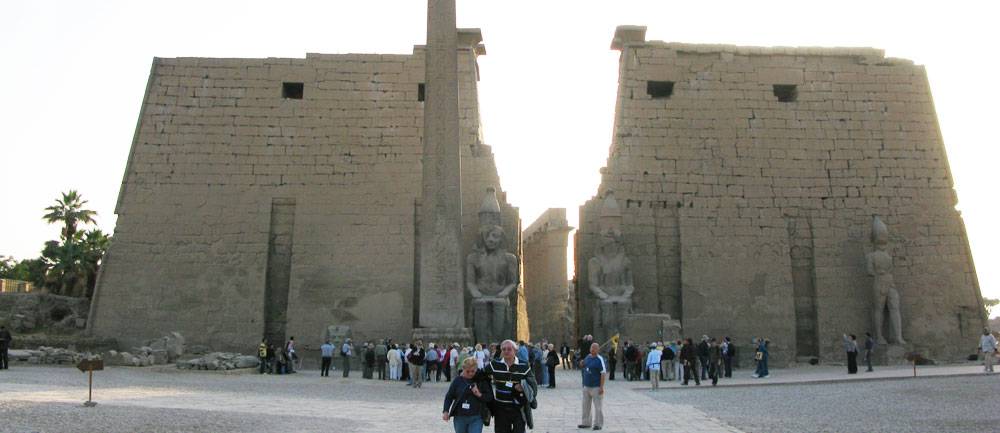
Around 2 PM we returned to the ship for a late lunch. That afternoon around 4 PM, we visited the nearby Luxor Temple.
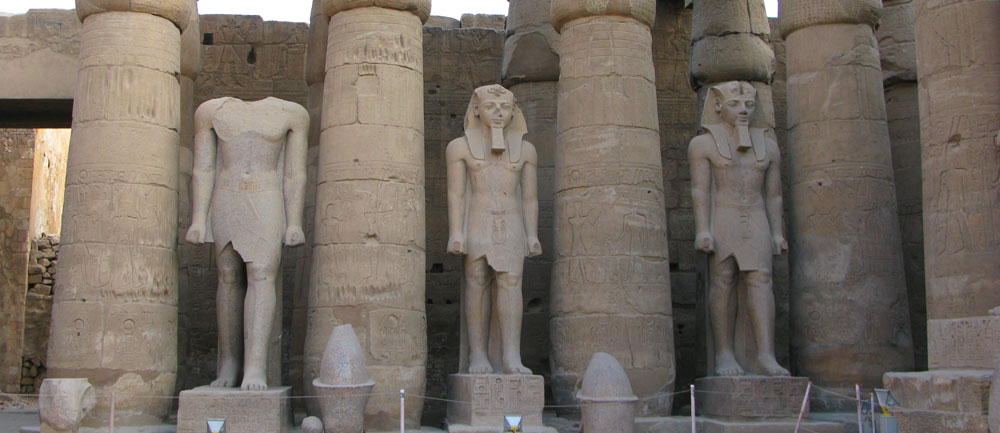
Unlike the other temples in Thebes, Luxor temple is not dedicated to a cult god or a deified version of the king in death. Instead Luxor temple is dedicated to the rejuvenation of kingship; it may have been where many of the kings of Egypt were crowned.
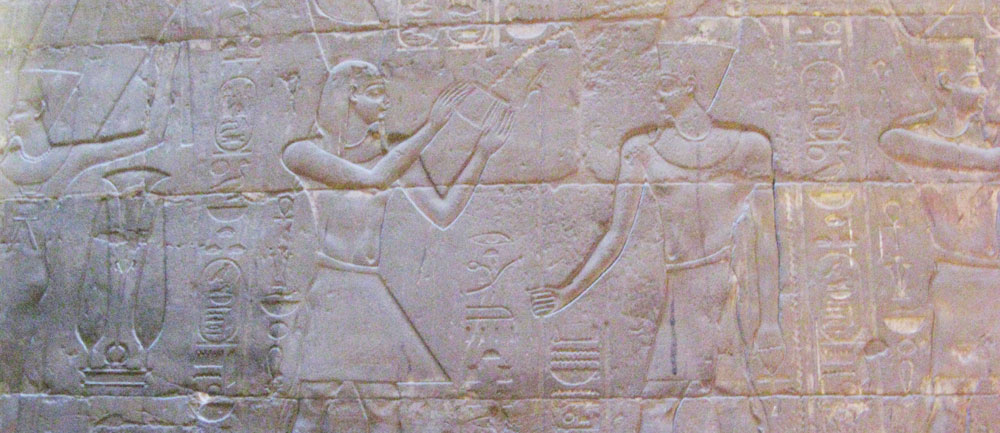
To the rear of the temple are chapels built by Amenhotep III, by Tutankhamun and by Ramesses II.
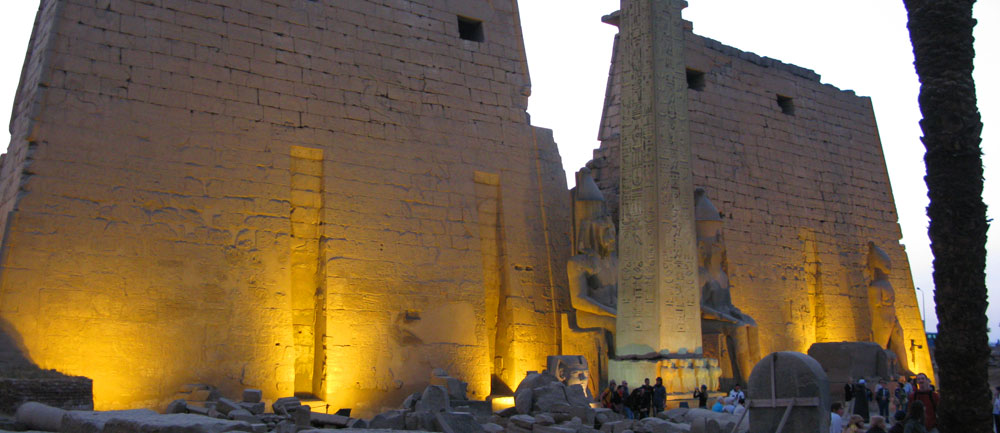
We stayed at the Temple of Luxor until sunset, Kathi taking still photographs and me filming.
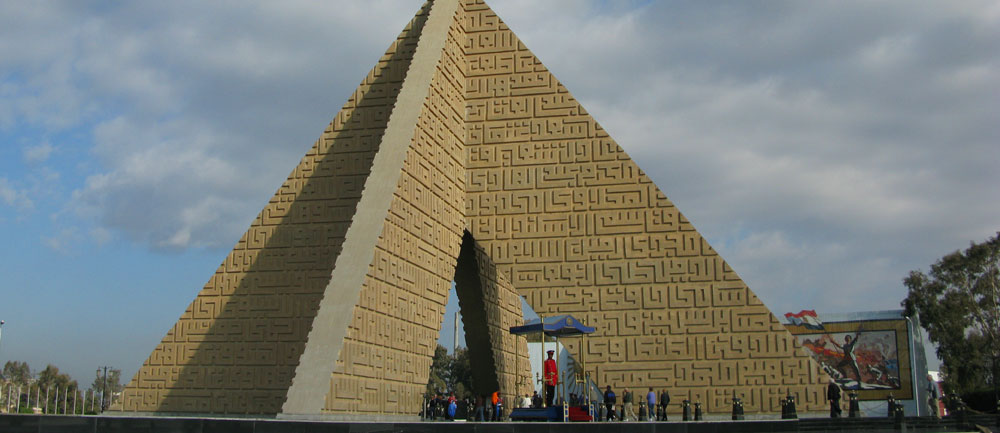
Friday - 11 January - After spending another night on the boat at Luxor, today we flew back to Cairo and checked in to the Ramses Hilton. Later in the day, we visited the Sadat Memorial. This pyramid-shaped monument was constructed by president Anwar Sadat in 1974 in honour of Egyptians and Arabs who lost their lives in the 1973 October War.
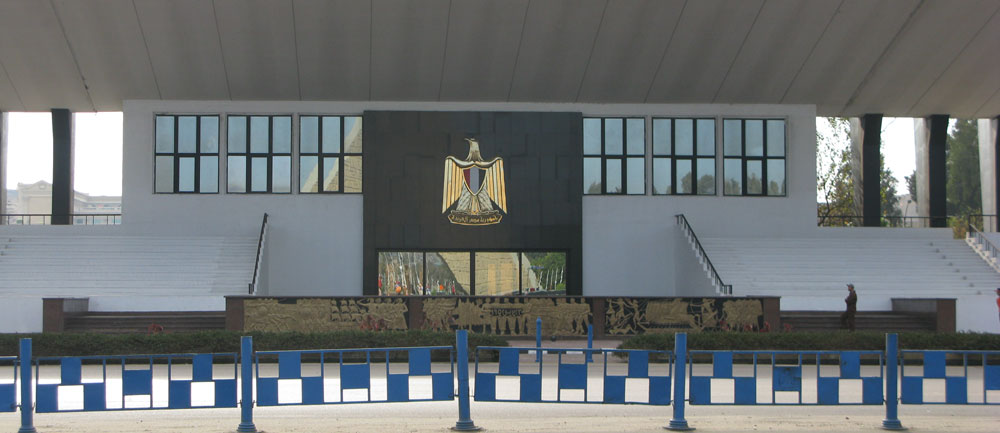
The site was also chosen for Sadat's tomb after he was assassinated in October 1981. Ironically, it sits directly across the street from the presidential viewing stand where President Sadat was assassinated.
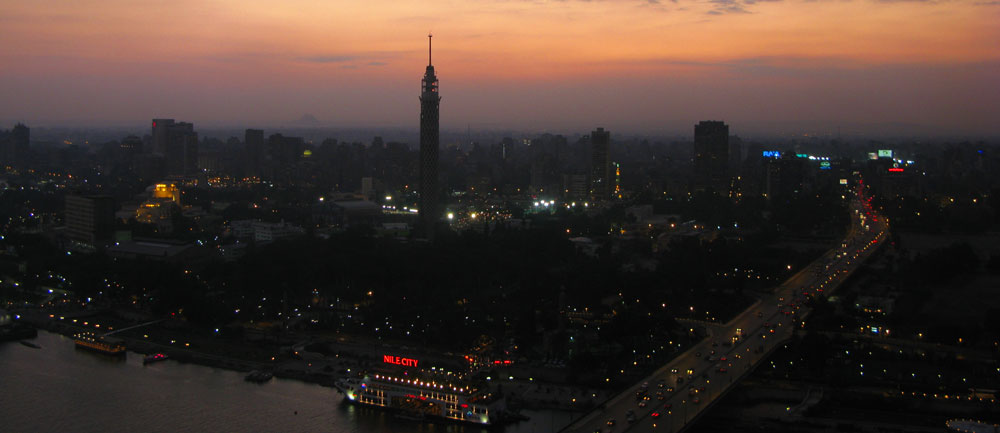
Saturday - 12 January - After a memorable farewell party at the top of the Ramses Hilton last night, we leave for the Cairo airport to fly home. We leave with hundreds of wonderful memories of Egypt.
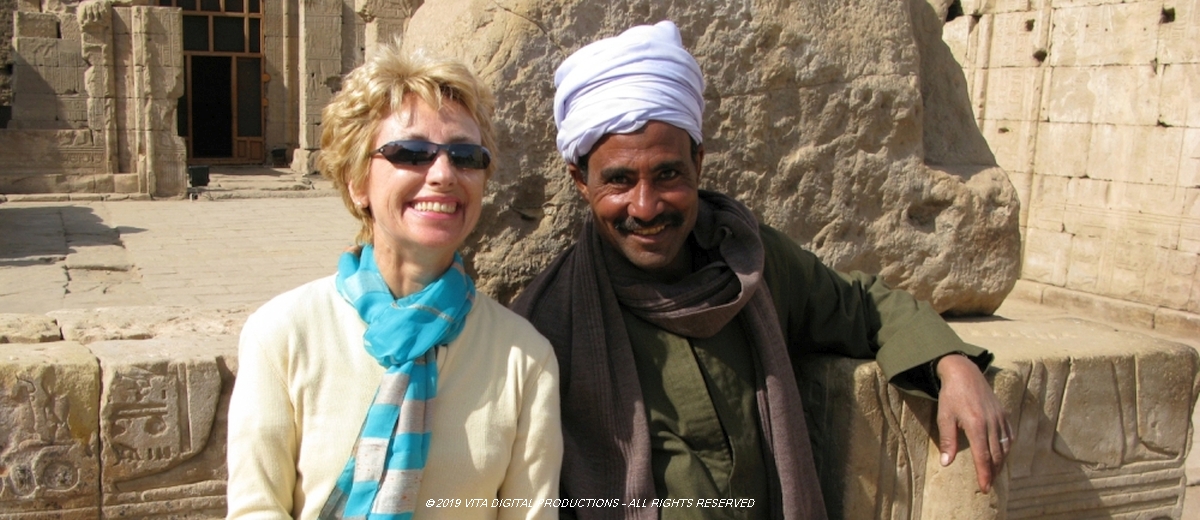
But without doubt the best memory of all was meeting and talking with various citizens of Egypt and being reminded that there are kind and gracious men, women and children in all corners of the world!
Upon returning home, we were gratified to learn that Kathi had taken 4,000 high resolution digital photographs and I had filmed over 30 hours of High Definition video footage while in Egypt, all of which we would be able to license to TV networks and movie studios.
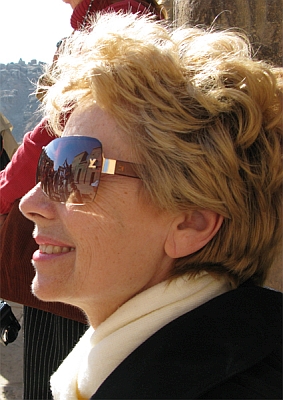
About the Author - Kathi Jacobs and her husband, Wayne, are the owners of VITA Digital Productions, a video production company specializing in creating Virtual Walks, Virtual Jogs, Virtual Cycling Scenery, and Virtual Cruises on scenic rivers. With over 50 different Virtual Experience Videos to choose from on vitadvds.com, VITA Digital Productions is the leading producer of Virtual Experience Videos in the world.